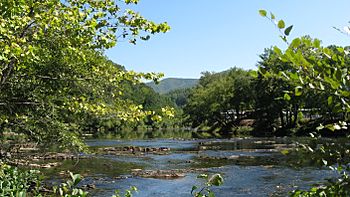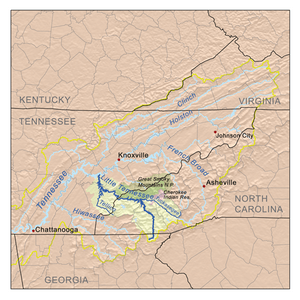Tuckasegee River facts for kids
Quick facts for kids Tuckasegee River |
|
|---|---|

View upriver from Old River Rd. above Bryson City
|
|

The Little Tennessee drainage basin
|
|
| Country | United States |
| State | North Carolina |
| Physical characteristics | |
| Main source | confluence of Panthertown and Greenland creeks 3,969 ft (1,210 m) 35°10′6″N 83°0′41″W / 35.16833°N 83.01139°W |
| River mouth | Lake Fontana 1,703 ft (519 m) 35°26′5″N 83°35′4″W / 35.43472°N 83.58444°W |
| Length | 60 mi (97 km) |
| Basin features | |
| River system | Little Tennessee → Tennessee → Ohio → Mississippi |
| Basin size | 655 sq mi (1,700 km2) |
| Tributaries |
|
The Tuckasegee River is a cool river that flows only in the western part of North Carolina. It begins in Jackson County. It starts where two smaller streams, Panthertown and Greenland creeks, meet up.
The river flows northwest into Swain County. Here, another river, the Oconaluftee, joins it. The town of Bryson City grew up right along the Tuckasegee. You can even visit Bryson City Island Park there. The Tuckasegee then flows into Fontana Lake, which was made by the Fontana Dam on the Little Tennessee River. Finally, the Tuckasegee River joins the Little Tennessee River below the lake.
Contents
What's in a Name?
The name Tuckasegee might come from a Cherokee word. That word is daksiyi, which means 'Turtle Place'. It's pronounced something like [takhšiyi] in the local Cherokee language.
Ancient Cherokee History
Many Cherokee towns were built along the Tuckasegee River a long time ago. One of the most important was Kituwa. Many people believe Kituwa was the "mother town" of the Cherokee people.
The Kituwa Mound
Kituwa was built around a special earthen mound. This mound was probably built around the year 1000 CE. Even though it's not as tall as it used to be, you can still see the mound today.
In 1996, the Eastern Band of Cherokee Indians bought back about 309 acres (1.25 km2) of this land. This area also includes where an early 18th-century Cherokee town once stood. In 1997, experts looked at the land and found proof that people had lived there for thousands of years. The Cherokee people are keeping this land undeveloped because it is sacred to them.
Townhouses and Community
Many mounds in this area were built around 1000 CE. This was during a time called the South Appalachian Mississippian culture. In their main towns, the Cherokee built a special building called a townhouse. They often built these townhouses on top of the mounds.
The townhouse was a very important building for the Cherokee. It showed how their society worked. They made decisions together as a community, not just by one leader. Sometimes, they built the townhouse in the main town square instead of on a mound.
Old Fishing Weirs
The Tuckasegee River also has several stone structures called weirs. These were built by ancient people who lived here before the Cherokee. These weirs were used for fishing.
You can see the weirs best when the river water is low. One of the best-preserved weirs is near Webster, North Carolina. It has a special "V" shape.
Fun on the River
The Tuckasegee River is a great place for outdoor activities. You can go fishing, hiking along its banks, or paddling in a boat. It's a beautiful spot to enjoy nature!

